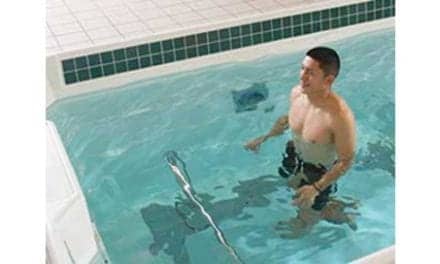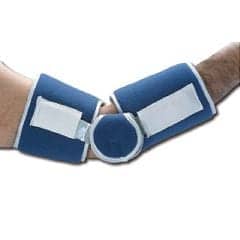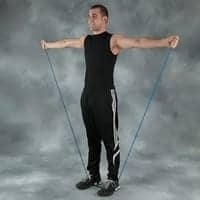
ActiveRx focuses on changing the way people age and think about aging. The company reports that it created Strengtherapy in response to a specific need: to demonstrate and publicize the benefits of strength training on the aging process.
By Wayne T. Phillips, PhD, FACSM, CIC, CVS-FR, and Rick Gawenda, PT
One of the most striking features of older adults referred to therapists at ActiveRx by physicians is that, whatever their specific diagnosis, approximately 90% present with significant, lifestyle-limiting muscle mass and strength deficits. By age 70 years, muscle mass losses can be as much as 45% of peak, and strength losses as much as 60%. With the continuation of this downward spiral, daily activities that were once taken for granted become more difficult and, for some, impossible.
While maintaining strength is regarded as important by most older adults, paradoxically, strength training for this population is little practiced or even accepted as appropriate exercise. This is despite the fact that more than 2 decades of research has unequivocally shown that strength training—particularly of higher intensity—is the key to increased strength, muscle mass, and physical function. Strength training is also not simply about getting stronger: recent research has shown it can significantly reduce signs and symptoms associated with chronic age-related health issues, such as sarcopenia, arthritis, osteoporosis, fibromyalgia, heart disease, and diabetes. This article presents evidence-based principles and guidelines that provide a template for a more professional assessment of the equipment’s safety, ease of use, and appropriateness for the desired population.
Principled Purchases
The type of equipment purchased can strongly support the success of any strength training program or strength-oriented plan of care. At ActiveRx, the selection process is based on the seven principles of Universal Design,1 a concept originated at North Carolina State University.2 These principles are (i) equitable use, (ii) flexibility in use, (iii) simple and intuitive use, (iv) understandable instructions, (v) minimize hazards, (vi) comfortable use, and (vii) appropriate size.
The equipment used in Strengtherapy Centers was selected largely because it met the requirements for the seven principles of Universal Design. Following are examples of the machines utilized in the centers’ rehab programs and other strengthening sessions for older adults.
Leg Press: The Eagle Leg Press from Cybex International, headquartered in Medway, Mass, is easy to understand and use. The movement associated with this machine is simple to perform and can be adjusted to the user’s height or physical ability. Its design allows the user to maintain a comfortable body position and a neutral spine, and the movement of the weight stack is smooth and continuous.
Chest Press: Chest press machines from Precor, Woodinville, Wash, HUR Health and Fitness Equipment, Northbrook, Ill, and Cybex International offer design advantages of being manufactured in an appropriate size and space for factors such as approach, reach, manipulation, and use regardless of user’s body size, posture, or mobility. With equipment that falls into these design parameters, the user can comfortably attain the initial lifting position and easily reach all adjusting systems.
Rowing Machines: The design of seated row machines from Precor and Rosemont, Ill-based Life Fitness can accommodate a range of individual preferences and abilities. The resistance can be graduated in small increments, and the machine is adjustable for a wide range of size, height, and range of movement choices.
Life Fitness Shoulder Press: The Life Fitness Shoulder Press is built with a design that provides the same means of use and access for all users. The seat is wide enough to provide good stability for individuals who span a wide range of size, height, and range of movement.
[sidebar float=”right” width=”250″]Product Resources
The following companies also provide products for resistance training:
Exertools
Fitter International Inc
Magister Corporation
NZ Manufacturing Inc
OPTP
SPRI Products
Stretchwell
TheraBand
Vonco Medical, Rehab
& Fitness
www.voncomed.com[/sidebar]
A Complete Field of Products
Though ActiveRx uses a specific purchase criteria for its Strengtherapy Centers, the general field of resistance exercise equipment available to the PT marketplace is broad, and offers a variety of facility-based equipment as well as tools that are affordable for home use. Among the smaller, more economic options used by the general PT market are elastic bands, tubing, and balls that can be used in the clinic as well as for exercise at home. Sources for these types of products include OPTP, Minneapolis, which offers Sanctband Resistive Exercise Bands as well as a wide selection of Thera-Band products including resistance tubing, loops, and resistance bands. Fitter International Inc (Fitterfirst), Calgary, Alberta, Canada, also provides equipment designed for strength building, including the Pro Fitter 3D Cross Trainer, designed to develop dynamic strength and stability across three planes.
Progressive Resistance Benefits
Physical therapy by its very nature is uniquely placed to advocate for, and support the findings associated with, strength training in older adults. However, traditional “strengthening programs” in physical therapy often utilize wrist/ankle weights and/or elastic tubing requiring only low intensity efforts on the part of the patient. Any strength gains produced in this way are likely to be minimal and transient related more to motor learning than a biological increase in contractile muscle protein.3
Well-designed treatment plans based on Progressive Resistance Exercise (PRE) enable patients to experience for themselves the benefits of increased strength and its long-term relevance to their lifestyle. Such exercises are best performed, at least initially, on strength training machines, ideally those adhering to the principles of Universal Design. The ability of therapists to select and apply effective strengthening practices, therefore, is paramount.4 Choosing the appropriate equipment for your clinic/plan of care is an essential part of this process. PTP
Wayne T. Phillips, PhD, FACSM, CIC, CVS-FR, is the Strengtherapy Research and Training Director for ActiveRx. He is a former postdoctoral fellow at Stanford School of Medicine, Center for Research in Disease Prevention.
Rick Gawenda, PT, is founder and president of Gawenda Seminars & Consulting Inc. He is also past president of the Section on Health Policy & Administration of the American Physical Therapy Association. For more information, contact [email protected].
References
- Phillips WT. Choosing strength training equipment for older adults: the benefits and advantages of Universal Design. In: International Council on Active Aging Developers Guide. 2009; 58-63.
- Center for Universal Design, North Carolina State University. The Principles of Universal Design. https://www.ncsu.edu/ncsu/design/cud/
- Sale DG. Neural adaptations to resistance training. Med Sci Sports Exerc. 1988;20(5 Suppl):S135-S145.
- Avers D. White Paper: Strength Training for the Older Adult. J Geriatr Phys Ther. 2009;32(4):148-152, 158.





